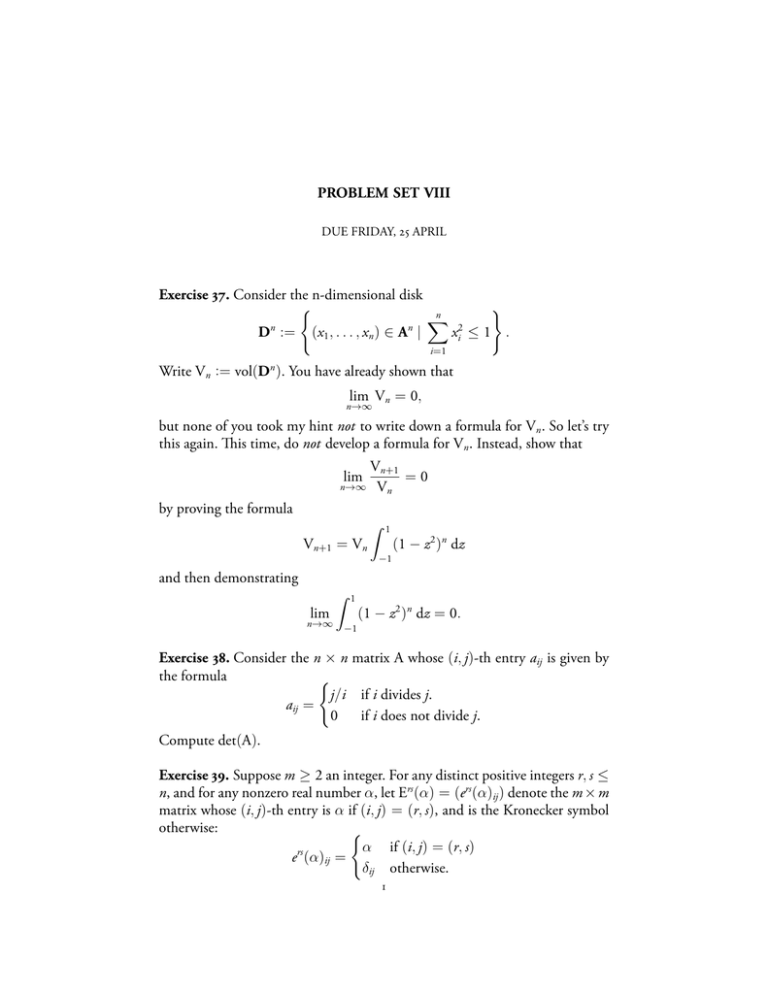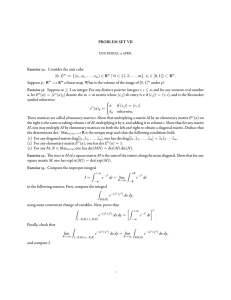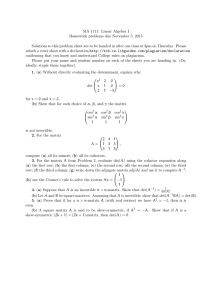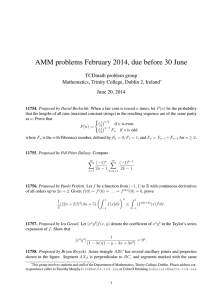PROBLEM SET VIII Exercise . D {
advertisement

PROBLEM SET VIII
DUE FRIDAY, APRIL
Exercise . Consider the n-dimensional disk
{
n
D :=
(x1 , . . . , xn ) ∈ A |
n
n
∑
}
x2i
≤1 .
i=1
Write Vn := vol(Dn ). You have already shown that
lim Vn = 0,
n→∞
but none of you took my hint not to write down a formula for Vn . So let’s try
this again. is time, do not develop a formula for Vn . Instead, show that
Vn+1
=0
n→∞ Vn
lim
by proving the formula
∫
Vn+1 = Vn
and then demonstrating
∫
lim
n→∞
1
−1
1
−1
(1 − z2 )n dz
(1 − z2 )n dz = 0.
Exercise . Consider the n × n matrix A whose (i, j)-th entry aij is given by
the formula
{
j/i if i divides j.
aij =
0
if i does not divide j.
Compute det(A).
Exercise . Suppose m ≥ 2 an integer. For any distinct positive integers r, s ≤
n, and for any nonzero real number α, let Ers (α) = (ers (α)ij ) denote the m × m
matrix whose (i, j)-th entry is α if (i, j) = (r, s), and is the Kronecker symbol
otherwise:
{
α if (i, j) = (r, s)
ers (α)ij =
δij otherwise.
DUE FRIDAY, APRIL
ese matrices are called elementary matrices. Show that multiplying a matrix
M by an elementary matrix Ers (α) on the right is the same as taking column r
of M, multiplying it by α, and adding it to column s. Show that for any matrix
M, one may multiply M by elementary matrices on both the left and right to
obtain a diagonal matrix. Deduce that the determinant det : Matm×m . R is
the unique map such that the following conditions hold.
() For any diagonal matrix diag[λ1 , λ2 , . . . , λm ], one has
det diag[λ1 , λ2 , . . . , λm ] = λ1 λ2 · · · λm .
() For any elementary matrix Ers (α), one has det Ers (α) = 1.
() For any M, N ∈ Matm×m , one has
det(MN) = det(M) det(N).
Exercise . e trace tr M of a square matrix M is the sum of the entries along
the main diagonal. Show that for any square matrix M, one has
exp(tr(M)) = det(exp(M)).
Exercise . Fix vectors v1 , v2 , . . . , vn−1 ∈ Rn . Show that there exists a unique
vector x ∈ Rn such that for any w ∈ Rn , one has
x · w = det(v1 , v2 , . . . , vn−1 , w).
In this situation, we call x the cross product of v1 , v2 , . . . , vn−1 , and we write
x = v1 × v2 × · · · × vn−1 .
Note that the cross product is a map (Rn )n−1 . Rn ; it does not make sense to
speak of the cross product of fewer than n − 1 vectors!
Exercise . Show that the cross product is an alternating multilinear map
(Rn )n−1 . Rn , and show that, for any vectors v1 , v2 , . . . , vn−1 ∈ Rn , one has
√
|v1 × v2 × · · · × vn−1 | = det M,
where M is the (n − 1) × (n − 1) matrix whose (i, j)-th entry is vi · vj .







